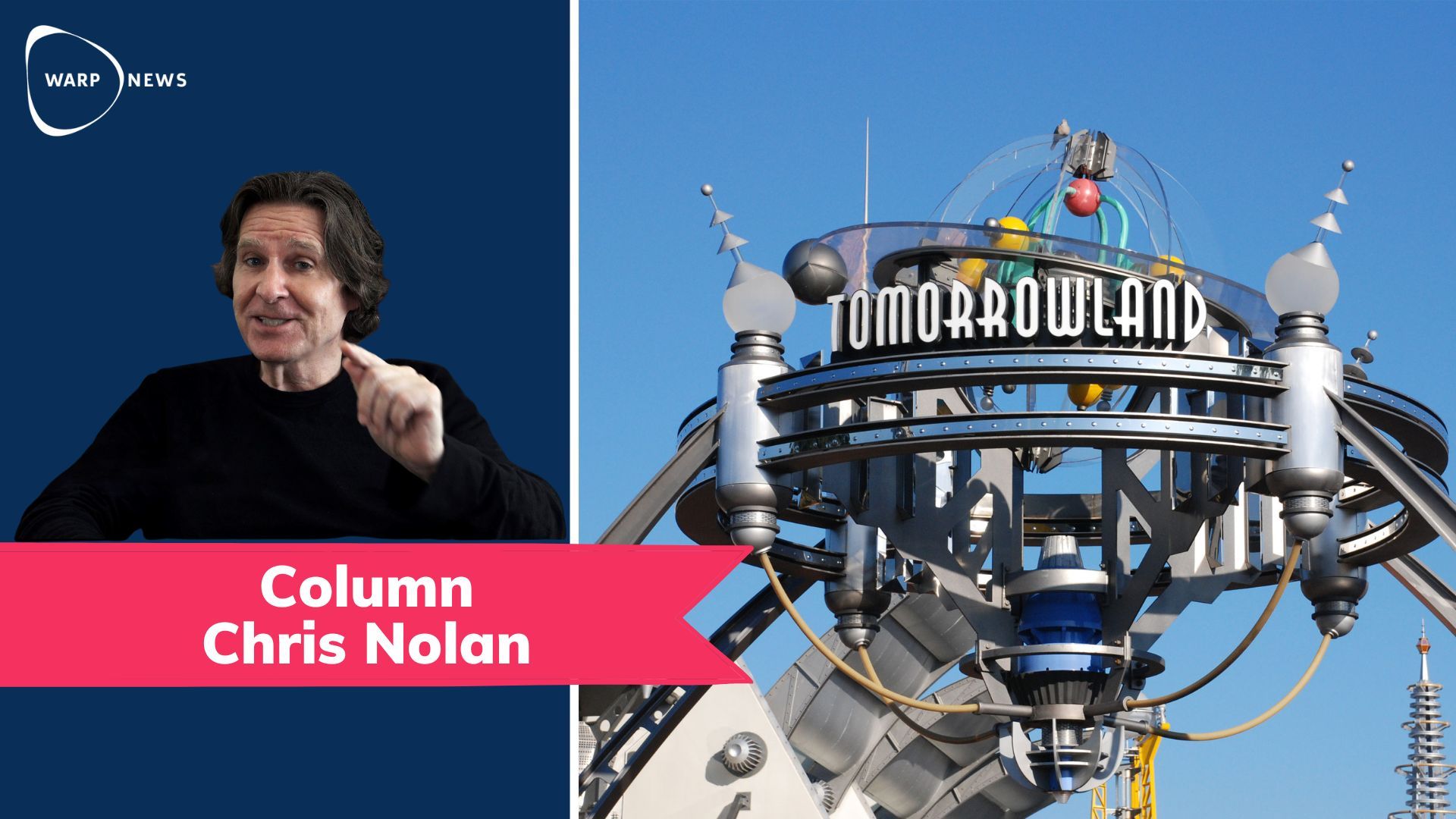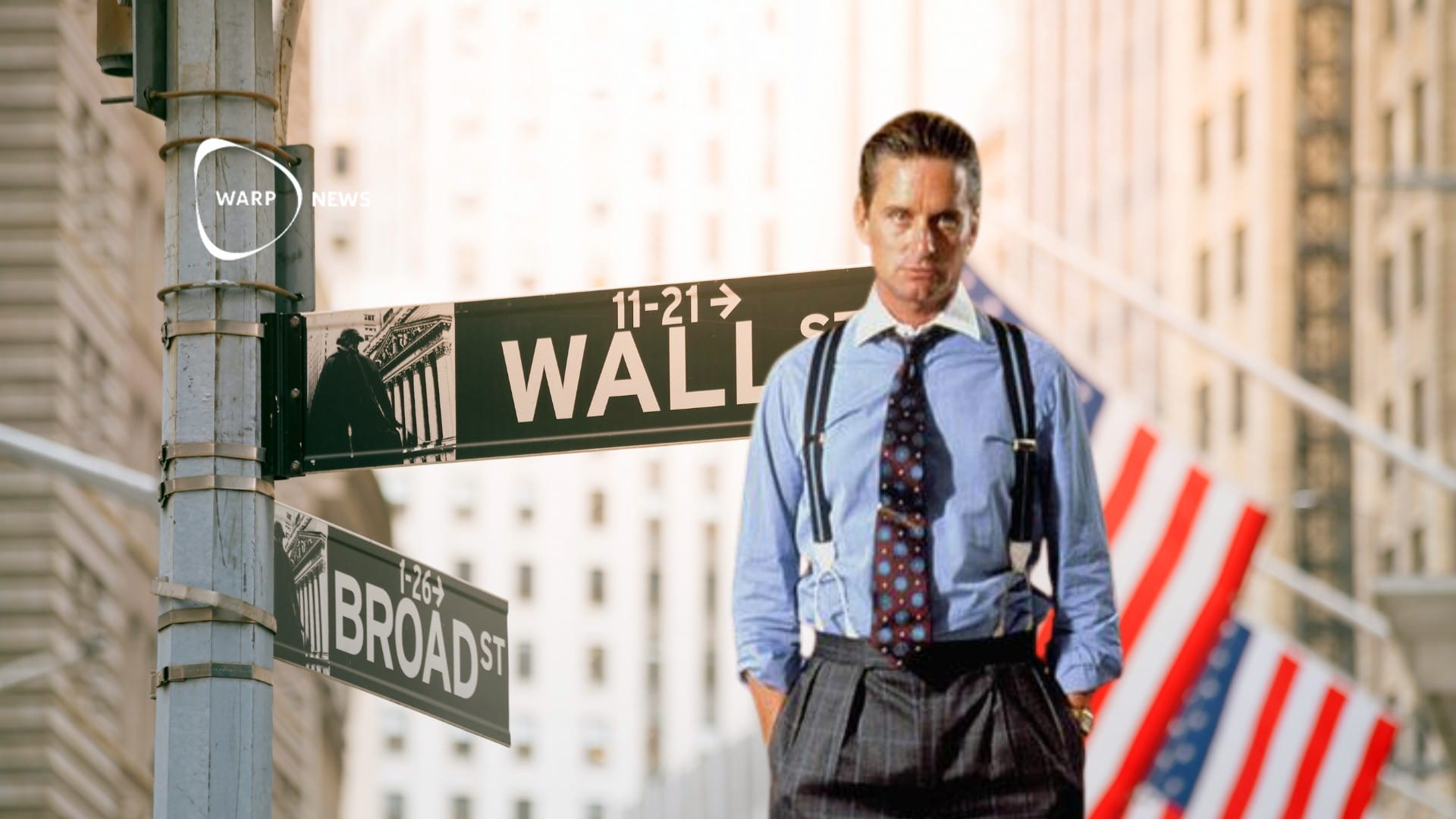
🎥 Chris Nolan: How storytelling can change the future — what’s wrong and how to fix it
Why is the real story of a better future not being told? And how can we fix that? Asked and answered by Chris Nolan, a multiple Emmy-winning director-writer.
Share this story!
Chris Nolan is a multiple Emmy-winning director-writer, author, story expert, branding expert and serial entrepreneur. He is working on a documentary TV series called Protopia: The Good Future.
Destination: Protopia
Futuristic Barbara Marx Hubbard said, “The future exists first in imagination, then in will, then in reality.” She added, “As you see the future, so you act and as you act, so you become.”
Well, what if we could imagine a world that is continually getting better, becoming more abundant, improving our livelihood and health, and creating unheard of opportunities and possibilities? What if that were, in fact, the world we are now living in? Then, according to Hubbard, we should all be acting and behaving with optimism and hope. Yet, the opposite is true. The world is awash in pessimism and fear of tomorrow. There’s a malaise, even a dread about the future.
So, what’s the disconnect? Why is the real story of a better future not being told? Why is the truth so distorted? And what’s that doing to our imaginations? Neuroscience tells us stories affect our physical and mental makeup on many different levels. Stories can change our brains and directly impact our thoughts, beliefs, feelings, and actions. They shape our world.
So, if our brains use stories to make sense of the world then how are the unavoidable and increasingly apocalyptic news and entertainment narratives shaping our worldview? It’s no wonder we can’t possibly see any good in the future. Or what Kevin Kelly, the founder of Wired magazine, calls Protopia. This isn’t Dystopia or Utopia but simply a future that is getting exponentially better and better.
The Good, The Bad and Your Brain
There’s a reason these negative stories stick with us. Human brains are evolutionarily wired to be nine times more negative than positive. The more fear-based the story, the more it catches our attention. Thus, the old newspaper adage, “If it bleeds, it leads.”
Unfortunately, this negative default mode can prevent us from seeing the good in the world (or even ourselves). When we’re always in survival mode, we have a hard time grasping just how abundant our lives are and why this is an amazing time to be alive. Yes, we have enormous challenges: The looming consequence of climate change, continued water and energy needs, geopolitical and social unrest, a growing marginalized population, species extinction, and a need for greater empathy for all living things.
But we’ve also doubled the lifespan of the average human, income around the world has tripled, and despite recent inflation, the cost of goods (food, energy, transportation and communication) has dropped 1000-fold. Global literacy has gone from 25 to 80 percent. Furthermore, technology continues to make things more available and sustainable by driving down the cost of food, energy, healthcare, and housing.
Soon the entire planet of eight billion people will be connected. When that happens the pace of innovation will be mind-boggling. AI will become ubiquitous and dramatically enhance human capabilities by allowing us to solve problems that have heretofore been unanswerable. But sadly, we don’t see progress. Because another neural glitch in our brain’s medial frontal cortex limits our ability to comprehend the speed of exponential change.
The human brain evolved in an environment that was local and linear. In our ancestors’ lives everything was a day’s walk away and the rate of change was very slow. Just over a century ago, the speed of a horse was as fast as information could travel. Now, if something happens on the other side of the planet, we hear about it a millisecond later. The world has not only become global but exponential. This new era is what I call VUCA MAX.
VUCA MAX: The Future is Moving Faster Than You Think
Massive accelerating exponential change really started kicking in around 2020 during a pivotal point in human history we weren’t prepared for. In our documentary: It’s VUCA: The Secret to Living in the 21st Century — our mission was to help the world catch up to these radically changing times.
VUCA is an acronym for Volatility, Uncertainty, Complexity, and Ambiguity. It was coined by the military in 1987 to explain the uncertainty of the 20th century and is a very apt way of explaining the conditions and environment of the early part of the 21st Century, in which we were witnessing Moore’s Law — every 18 months the power of technology was doubling — and transforming the world. It’s why the smartphone in your pocket is now a million times faster, a million times cheaper, and a thousand times smaller than a supercomputer in the 1970s.
Now, the exponential convergence of Moore’s Law, Metcalfe’s Law, and Wright’s Law have created VUCA on steroids. The doubling is converging and compounding. VUCA is now Massive, Accelerating and eXponential. It’s now VUCA MAX. To give you an idea just how fast the future is moving, in the next 10 years we will see 100 years of change. In the next 80, we’ll see 20,000 years.
Unfortunately, our evolutionary propensity for negativity and linear bias overwhelms us and leaves us vulnerable to our worst fears and distorted dystopian outlooks. It not only blinds us to the truth about the future, and how the future is more abundant than ever — but it also has an adverse impact on our mental health.
Can Entertainment Save Tomorrow?
There’s always been criticism of the news media and entertainment emphasizing sensationalism and exaggeration over reality. Fear-mongering and manipulation go back to yellow journalism culminating with Orson Wells’ 1938 radio broadcast of a Martian invasion.
Now, of course, we know that dystopian scenarios in movies and networks are fictitious. However, given our predisposition to fear and negativity, the entertainment media must be aware of and held both responsible and accountable for the creation and manipulation of the public zeitgeist. Going forward, I will make the augment that there are ways to dramatize narratives and even present dystopias, but still create a more balanced, realistic, and even exciting view of the future.
Tomorrowland
“Tomorrow is a heck of a thing to keep up with.” — Walt Disney.
Walt Disney was a technological innovator, science fiction storyteller, and futurologist. He dedicated Tomorrowland with the words:
“A vista into a world of wondrous ideas, signifying man’s achievements … a step into the future, with predictions of constructive things to come. Tomorrow offers new frontiers in science, adventure, and ideals: the Atomic Age, the challenge of outer space, and the hope for a peaceful and unified world.”
As part of the Disneyland television show, Walt presented three one-hour “science factual” episodes that mixed humor with hard scientific facts to give the audience an exciting glimpse into the future.
Let’s contrast that protopian vision with the 2015 movie, “Tomorrowland”. In the film, the antagonist sabotages humanity’s vision of the future by beaming horrific prognostications and the imminent collapse of the human race into everyone’s heads. And since our brains are wired to gobble up negativity and fearful information, the antagonist’s broadcasts easily transformed humanity into a pessimistic and hopeless populace without will, purpose, or dreams.
Although the villain is a bit stereotypical, the theme and plot mirrors what’s happening in our world today. Namely, that a constant fare of grim, paranoid, fearful apocalyptic programming can’t be good for our heads.
No Future Is Perfect
Hollywood movies and TV haven’t always tilted toward dystopia. The classic sci-fi movie “2001: A Space Odyssey” had some dystopian themes (everyone remembers Hal) but it also portrayed the evolutionary development and limitless potential of the human species.
Two seminal futuristic narratives of the 1970s, “Star Wars” and “Star Trek”, also had some dystopian story elements but overall, they were positive narratives with hopeful endings. Star Trek narratives took on many weighty themes including racism, religion, genocide, extinction, mental illness, sexism, morality, death, and time travel.
And even though Star Trek took place in space, the stories were always allegories about life on Earth, which is why the Star Wars and Star Trek franchises have been charting a course for a hopeful future for half a century — while many dystopian-themed programming has exhausted their storylines.
Where Is Our Lucy?
Ironically, Star Wars and Star Trek were not easy sells. All but one studio turned Star Wars down and no major studio would touch Gene Roddenberry’s plan for a race and gender-integrated crew representing the future of humanity. In fact, if it weren’t for Lucille Ball, there would be no Star Trek.
Lucy had just divorced Desi and was now running their independent production company Desilu. Star Trek was sold as a western in space, but the pilot was rejected by NBC. The series was dead. But, because Lucy was now swimming in profits from reruns of “I Love Lucy”, she did something unheard of. She paid for a second pilot and is credited as the main reason Roddenberry achieved his positive vision for the future.
Some might say dystopias are an easier sell and perhaps even easier to write. Or as British Sci-Fi writer Brian Aldiss calls them, “cozy catastrophe” stories. Many are basically horror stories with simple plots and clearly identified evil. Protopias on the other hand build plotlines calling for deeper multidimensional layers, character development, and complexity.
Positive Signs: It Can Be Done
Cory Doctorow is one of the most relentless and inventive authors writing at the junction between speculative fiction and real tech. Doctorow is on a mission to inspire positive futures. “Protopia is not the assumption that nothing will go wrong. Being hopeful means believing that when things break down, we can rebuild them. It’s still possible to model positive future outcomes and have a dramatic story.” Doctorow adds, “Disasters are where we rise to the occasion. They are humanity’s best moments, when we sacrifice ourselves for others.”
This is one of the things we addressed in the documentary, “It’s VUCA. The Secret To Living in the 21st Century”, that in times of great chaos and uncertainty, people have always demonstrated the greatest fortitude, resilience, courage, and empathy for each other. Things go wrong. People make mistakes and disagree, especially concerning the criteria used to govern technologies or how to deal with big complicated, future challenges — but we figure it out.
A shining example of a Protopia film is “Arrival” directed by Denis Villeneuve based on the short story “Story of Your Life” by Ted Chiang. It’s about a linguist enlisted by the United States Army charged with learning how to communicate with extraterrestrials that have arrived on Earth before tensions lead to an intergalactic war. “Arrival” not only provides a window into what communicating with other sentient species might look like, but it also portrays aliens as bent on saving humanity rather than annihilating it.
The Power Of A Single Image
Even a single image can change the story.
In 1966, the world was consumed by pictures of mushroom clouds and atomic bomb tests. The images of the nuclear blasts made people feel that civilisation was doomed. Being a photographer and activist, Stewart Brand knew that images change people’s behaviour. So he began a campaign for NASA to release an image of the whole Earth in space.
Brand even made-up buttons that asked, “Why haven’t we seen a photograph of the Whole Earth yet?” When NASA finally released the image of the Whole Earth taken by NASA astronauts, this single, hopeful, beautiful image blew away the dark atomic clouds.
People not only saw a brighter future but it helped create what became the transformative ecological movement. We were no longer passengers on a planet, we were the crew and responsible for its wellbeing. This one image changed the story from humanity being capable of destroying itself with technology to humanity being capable of discovering itself.
Sixty Seconds To Protopia

As a branding and storytelling expert, I’ve had first-hand experience with the power of story and messaging. One of the best examples is Apple’s “1984” considered the greatest TV commercial ever made. It opens in a dystopian world that’s disrupted by a singular woman who hurls a sledgehammer at a giant screen displaying the Big Brother broadcast — destroying it. Not only did the revolutionary ad almost single-handedly bring computers into the mainstream, changing the world as we know it, but it defined in our minds Apple’s protopian vision of the future of technology.
We now envisioned computers as empowering individuality and saving humanity from a bleak future of control. A control represented at the time by the giant computer behemoth Big Blue or IBM. Today, Apple is the most valuable company in the world whereas IBM no longer sells personal computers and is one-tenth the size of Apple. It’s a stark example of how the stories we tell about the future contribute to how we imagine the future, which in turn can become reality.
Bringing The Future Home
Kevin Kelly, the founding executive editor of Wired and former editor and publisher of the Whole Earth Review (the descendant of Stewart Brand’s Whole Earth Catalog) postulates:
“Perhaps at this stage in civilization and technological advance, we enter into permanent and ceaseless future-blindness. Utopia, dystopia, and protopia all disappear. There is only the Blind Now.”
Kelly continues to hope that our current future-blindness is only a passing phase that future-blindness is not an inescapable or permanent affliction of our modern world, which brings us back to storytelling.
Once Upon a Time in America we were so excited and awestruck by the possibilities of the future that we celebrated progress with a worldwide story known as The World’s Fair. New York World’s Fair featured “The World of Tomorrow” and people came back from it proudly sporting buttons that said, “I Have Seen the Future.”
I grew up in Seattle where The Century 21 Exposition in 1962 (also known as The Seattle World’s Fair) saw the construction of the Space Needle, now the iconic symbol of The Jet City. Century 21 featured a futuristic monorail and a trip to a better “World of Tomorrow” which, ironically, was during the height of The Cold War. “The World of Tomorrow” began with a ride in the Bubbleator, a 19-foot diameter spherical Plexiglas elevator. General Electric and Johnson’s Wax built model home interiors that brought the future home. It explored the life of the woman of tomorrow, featuring a household with “push-button ease” for everything but changing the baby.
World’s Fair’s partnered with leading American companies and entertainment companies to educate people about the future. At the 1964 New York World’s Fair, Disney debuted four major attractions including Ford’s Magic Skyway, It’s A Small World sponsored by Pepsi-Cola/UNICEF, Great Moments With Mr. Lincoln from the State of Illinois, and General Electric’s Progressland. These attractions eventually became part of Disneyland’s Tomorrowland. And, following their success, Walt moved forward with Project X, which would become EPCOT — the Experimental Prototype Community of Tomorrow.
These World’s Fairs helped humanity visualize, celebrate, and physically experience technological progress and the benefits of the future. Unfortunately, the last World’s Fair in the United States took place in 1984.
A Way Forward: Urgent Optimism
Jane McGonigal from The Institute For The Future believes, “This is a time for urgent optimism.” We need to flip the script on the dark future otherwise heading into the unknown has little value. In other words, we have to believe the struggle is worth it. But to do this, the future needs champions.
Whether the story is presented by an entertainment company, a corporation, a city expedition or an individual with a vision, we need to embrace Protopia narratives and experiences. Stories that become a force for The Good Future and positive stewards of renewed optimism. By guiding the world toward a more realistic view of the future, we empower people, especially younger generations, to believe things are getting better, not worse — and give them hope and inspiration that they can meet the grand challenges of tomorrow.
Today, young people are chronically pessimistic and depressed about their future. In a recent survey of 16 to 25-year-olds in ten countries over 50 percent said, “humanity was doomed”, which is why it’s more important than ever to behave as if the world is evolving not collapsing. It only takes one person with the vision and the right story to change the consciousness of the planet.
As Barbara Hubbard said: “How we see the future determines our story, how we act, and become.”
Let’s uplift imaginations toward the unimaginable possibilities and abundance ahead. Let’s reverse fear and the dystopian zeitgeist by creating stories that can change the world for the better and inspire bold vision and ambitious action. And empower people to become the heroes of tomorrow’s stories.
Chris Nolan
Chris Nolan is a multiple Emmy-winning director-writer, author, story expert, branding expert and serial entrepreneur. He lives in Santa Monica, California.
His latest documentary It’s VUCA: The Secret to Living in the 21st Century. His latest book is VUCA MAX: The Future of Leadership and Peak Performance Coaching
He is working on a documentary TV series called Protopia: The Good Future. It is part of The Good Future Project.
By becoming a premium supporter, you help in the creation and sharing of fact-based optimistic news all over the world.


